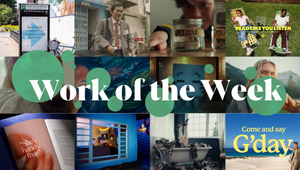
Nic Houghton on Emotion, Rhythm, and Cutting with Feeling

This is Nic Houghton. Orderer of abstraction, 'chef', and senior editor at Arketype. Nic ignores all preconceptions when entering a project. He loves abstraction, finding a visual's emotional undercurrent or vibe even without a narrative. Nic treats his edit like a puzzle - following the curves and dips of the pieces, rather than forcing everything together to fit the original plan.
LBB> The first cut is the deepest: how do you like to start an editing project?
Nic> Aside from the obvious prelim conversations with Directors and Creatives, when I get into the project file I habitually start with sound first. Listening to music references, adding temporary sound effects, and laying the audio foundation is my go-to method for structuring an edit. I always say, "Let the footage guide you," but without the emotional underpinning of audio, there's nothing. Then comes the fun part: watching all the footage (at least twice!) and beginning the selection process.
LBB> Rhythm and a sense of musicality seem to be intrinsic to good editing (even when it’s a film without actual music) – how do you think about the rhythm side of editing, how do you feel out the beats of a scene or a spot? And do you like to cut to music?
Editing is all about rhythm, in my opinion. It’s the rhythm of the narrative, the emotion, or even the literal beat of the song you're using. Letting this guide you is crucial to finding the pace and flow that the visuals want to be. Avoiding this is antithetical and goes against the essence of creating a great spot, music video, or whatever the end result may be.
The way that rhythm manifests in each scene can vary - whether through storyboards, the music chosen, or the actors’ performances - but it will always be there! Based on the above, it won't surprise you that I prefer cutting to music whenever possible, although it’s often just a preliminary guide until the spot reveals its inherent rhythm.
LBB> Tell us about a recent editing project that involved some interesting creative challenges.
Nic> A few months ago I worked on a pretty ambitious music video for the recording artist Lubalin, and that was full of very fun challenges. The director had all of these VFX and visually graphic ideas that went hand and hand with the editorial work, so we were editing and creating VFX simultaneously in the session together. Tons of trial and error, testing and experimenting, using outside sources (ie. running picture through CRT TVs and capturing the result back onto the camera) and seeing what stuck at the end of the day.
It was long days and not everything worked or was kept in the final cut, but the overall process was a ton of fun and creatively engaging. I felt like a kid making skateboard videos again.
LBB> Who are your editing heroes and why? What films or spots epitomise good editing for you?
Nic> My go-to, slightly unconventional answer for this question is Ty Evans. I was a skater kid and Ty Evans is a real OG skateboard video Director, editor, and DOP. His skate videos are the reason I ever even got into this industry in the first place. Fully Flared is the best, go watch it!!! In a more conventional answer I’d say Jéôme Pesnel, Cécile Decugis and Jingo Yang. Also: Bram van Dijk, Fouad Gaber, Emilie Aubrey, Nik Kohler, Neal Farmer, Mah Ferraz, Nick Yumul - the list could really go on.
In terms of editorially great visuals, I tend to love when people get a bit weird with it - Enter the Void, Sampha’s 'Process' film, anything done by Yulya Shadrinsky, Breathless. Again the list could go on forever.
LBB> What’s harder to cut around – too much material or not enough? (And why?)
Nic> Too little! Who wouldn’t want more sand to play with in the sandbox? Having to kill great things is a much better option than having to compromise the visual because you’re missing that one perfect clip or moment from the footage. I’d rather have to spend a week derushing than not have enough to work with.
LBB> Have you noticed any trends or changes in commercial editing over recent years?
Nic> The strive for authenticity. You see it everywhere, people pushing harder and harder to find an authentic voice, those grounded visuals, the REAL point of view. I think it’s great that things are moving towards that feeling. Advertising can be really damaging in some instances, so I think having it brought closer to an authentic place can be really healing and helpful for the general public. After all, as commercial editors we make things that most people find an annoyance and mute or skip when they are beamed onto their screen. Maybe by having ads be authentic to the human experience we can bring some better energy into peoples lives.















